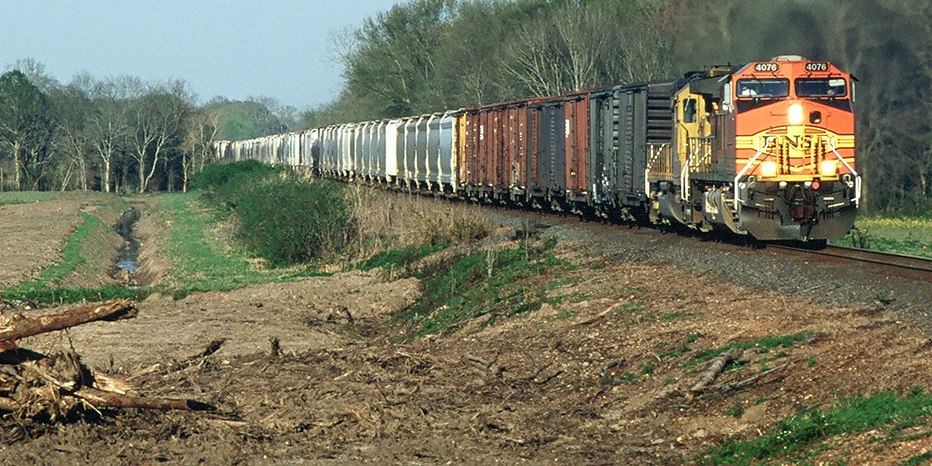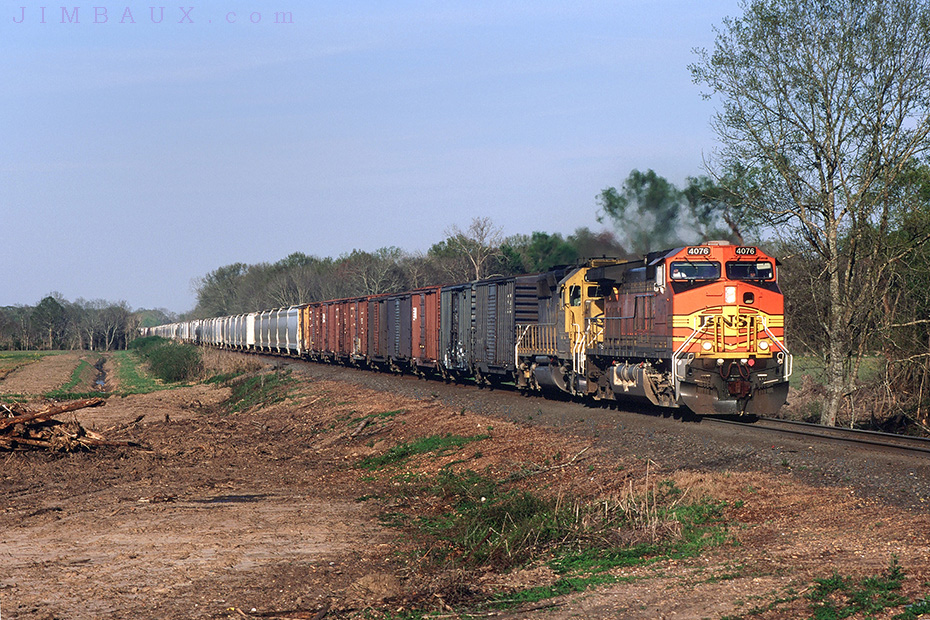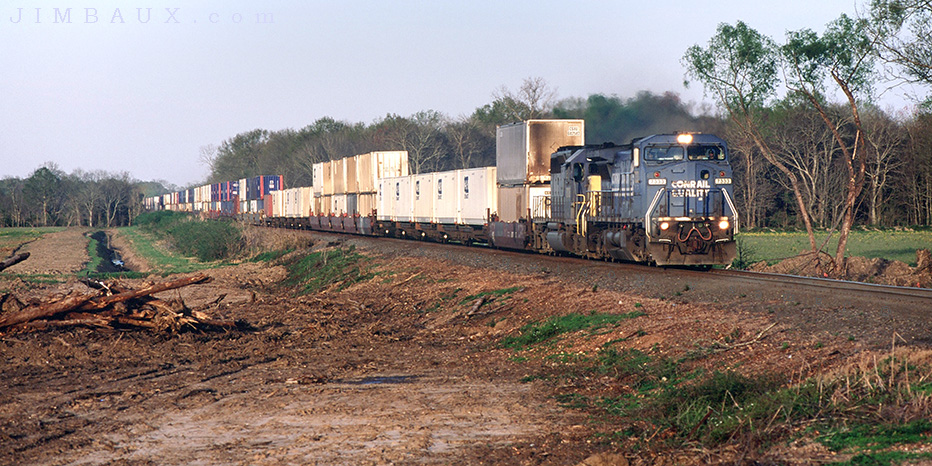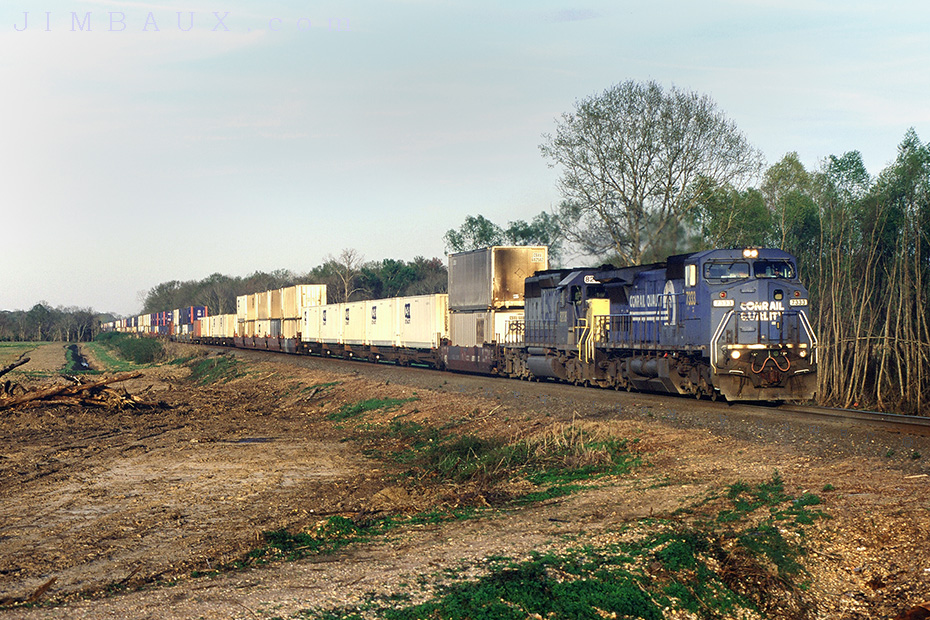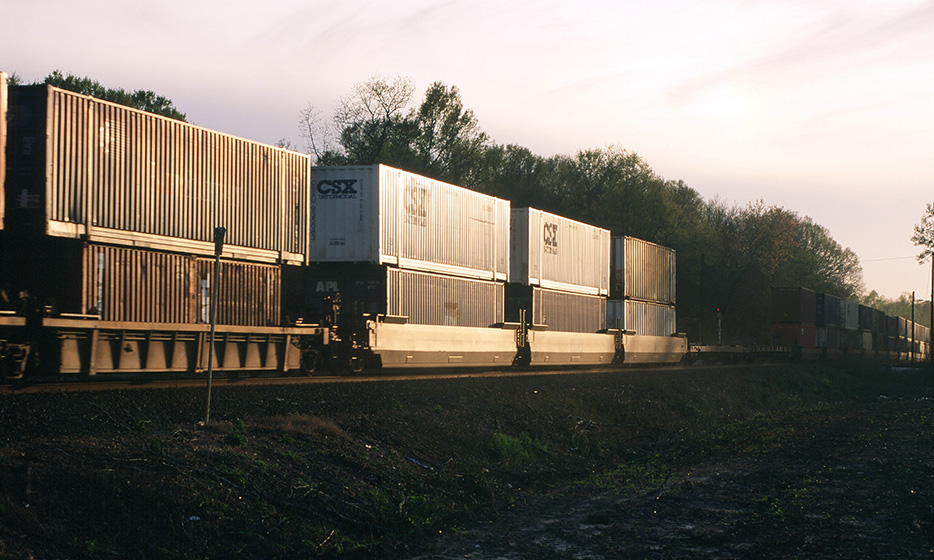One of my favorite regular places to watch and photograph trains on the Lafayette Subdivision was known as Thibodaux Junction on Acadia Road in northern Lafourche Parish one mile east of Schriever (which is in Terrebonne Parish.) I say “was” because the location is no longer publicly accessible, since the parish turned the right-of-way over to farmers in early 2005, robbing me of a real gem of a location at which, as far as I know, I was the only person who regularly – or even almost ever – photographed trains.
However, even though I started taking pictures of trains in the late 1990s and seriously in 2001 (and more seriously in 2002, and even more seriously in 2003, when I got my first mid-range telephoto lens, the Nikkor 80-200mm/f2.8), this location was only a regular spot for me for a briefer time – simplified by calling that time “the year 2004” – due to the fact that it was tree-lined prior to around the beginning of that year. Late afternoon summer lighting did allow some telephoto-wedge shots a few hundred feet from the track prior to 2004, but it wasn’t until many of the trees were cleared near the crossing that new and better shots opened up, which you will see here as scanned Fujichrome slides, thanks to Petersen Studios.
In retrospect, though, it is easy now to see these “developments” of the land as a precursor to me not being able to access it; the cliché “the only constant is change” comes to mind, and that is true not only with what happened to the location in which these pictures were taken but also of the lead locomotive of one of the trains that we will see today.
I need to explain why this location is called “Thibodaux Junction” and the significance thereof, but a better explanation will be made once you see one of the pictures here. For now, I can tell you that we are just east of milepost 54 of the Sunset Route and fewer than 1,000′ from the eastern end of the siding at Schriever.
On Sunday 7 March 2004, the day after I shot another IATCI at this same location, in the hopes of seeing and photographing the loaded coal train that The Shadow Warrior had seen, I ventured trackside. I did not see the coal train, but I did see two westbound trains, including the stack train that The Shadow Warrior, who died of pancreatic cancer nine years later, saw.
Our first of two trains is an unidentified BNSF manifest train (the NWOBEL, NWOBAR, NWOLAL, and NWOPTR were common trains of the time period) led by BNSF 4076.
The second locomotive was a Yellowbonnet SD40-2, the BNSF 6942; the train had 424 axles, which I could tell because I could hear the automated reading from the detector at milepost 49.6 from this spot, whereas I could not (and usually still can not) hear it from Schriever, another reason why this location was so valuable (meaning that I could be sitting there in my truck reading a book or doing some paperwork and be alerted to an oncoming train before it came into view.)
Please note in the above picture the pile of former trees at left, which recently as actual trees blocked this view, and please notice the sugarcane field in the background, the likes of which occupy the foreground today; such is the case as urban sprawl (from Thibodaux) encroached on older cane fields.
Here is a cropped version of the above image.
You can probably already see why I loved this location so much, and the shot from the other side of the track was almost as good too, but the above view would greatly be improved by about 20′ of elevation, because the line formed by the tops of the trees is too close to that formed by the top of the train, causing this view to be a little bit too tight for my likes, but that’s okay.
Isn’t that neat?
Our second train, which Shawn had seen earlier in the day, was Union Pacific’s IATCI (Intermodal – Atlanta, Ga., to City of Industry, Ca.), a run-through intermodal train for the CSX to the UP, the predecessor to the KATCI and the ZATLA and ZATLC trains, and this train shows something else that is no longer with us: Conrail-painted locomotives on the CSX.
How is that? That is something that you don’t see anymore! I really miss the Conrail, not that I ever really ‘knew’ it in the first place. Our next picture, which is of the same train, is what I will use to explain why this place is called “Thibodaux Junction” and paying particular attention to the foreground.
Normally, I crop out the bottom portions of images like the one that you see above, but I left it in this picture to show you what was a leg of a wye. which you can see going toward the mainline from the lower-left corner of the frame. What was known in later Southern Pacific railroad times as the Napoleonville Branch – where I first and often saw trains as a child – diverged from the mainline just west of here at the east siding switch of Schriever in an eastward direction, meaning that a train entering the branch had to do so from the siding, not the mainline (at least once this eastern leg of the wye was removed.) What was known later as the “Napoleonville Branch” was originally built just into Thibodaux, a city that did not want a mainline railroad, which is why the New Orleans, Opelousas & Great Western – the original railroad here – turned southwestward at Lafourche Crossing, avoiding Thibodaux, and creating the town of Schriever – called “Terrebonne Station” at first and later named after a railroad official.
Anyway, what you see in the above picture in the foreground is the remains of the roadbed of the eastern leg of the wye, which was probably removed not long after the end of steam operations. In Thibodaux, the SP (or one of its predecessors) extended the branch to Napoleonville; the switch at Canal Boulevard in Thibodaux was therefore known as Napoleonville Junction. So, Thibodaux Junction was where the branch to Thibodaux diverged from the mainline in both directions, and Napoleonville Junction was where the Napoleonville Branch branched from the Thibodaux Branch, but in later years, the entire thing was known as the Napoleonville Branch (even when it terminated in Supreme.)
Looking now to the west as we watch this passing train taking stuff to California, we can barely see the remaining stub of the Napoleonville Branch at the far right.
Three years and three months later, with this new thing called a digital camera, I took some pictures (the last three in the post linked here) that show what remains of the Napoleonville Branch. I have really only tried to do the westbound shot here – but not really “here,” since you can’t get there anymore – in the digital era, and that was when a special event happened that I felt the need to record: the last BNSF train out of New Orleans before Hurricane Isaac.
Does this make sense? I hope that you enjoyed this trip back in time.
Good night.
Jimbaux

